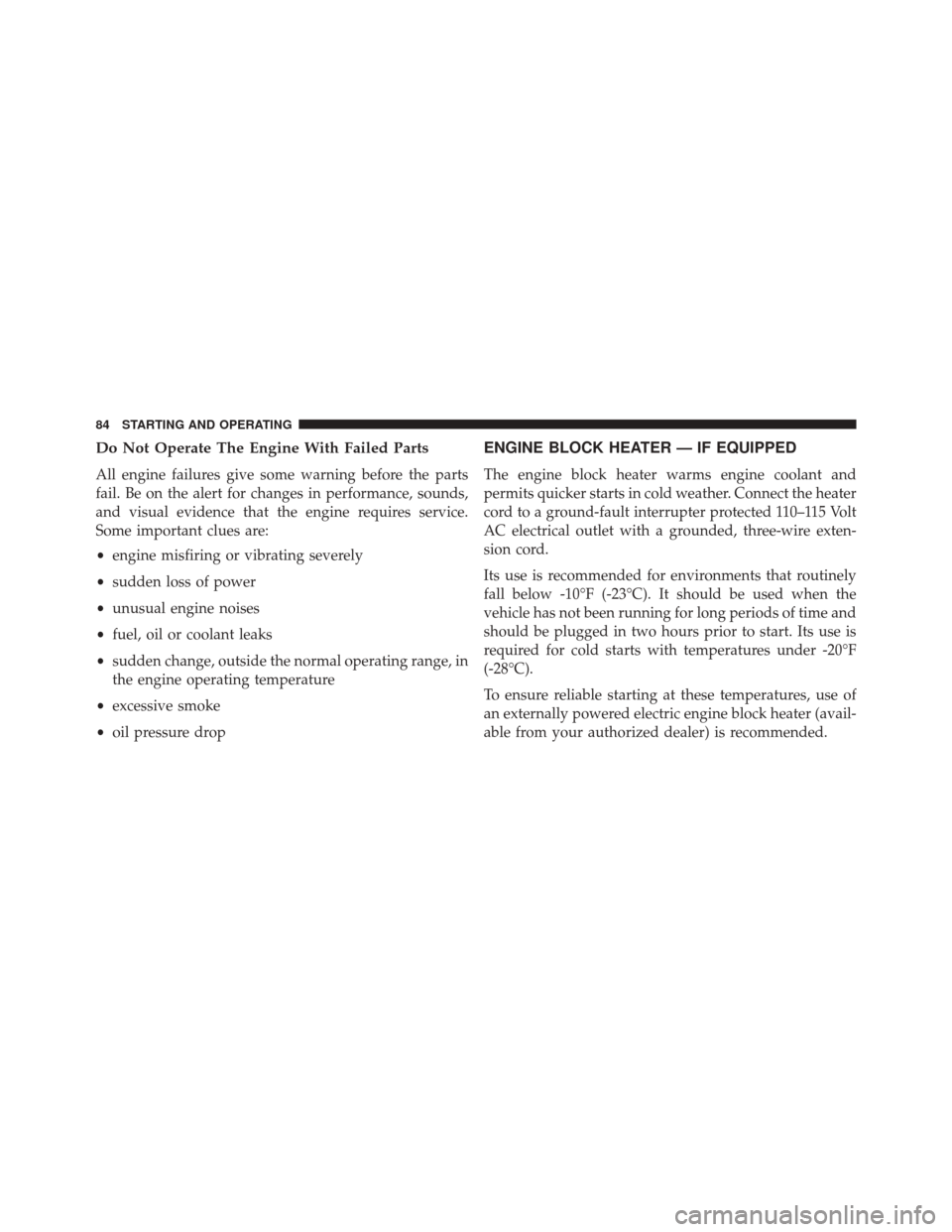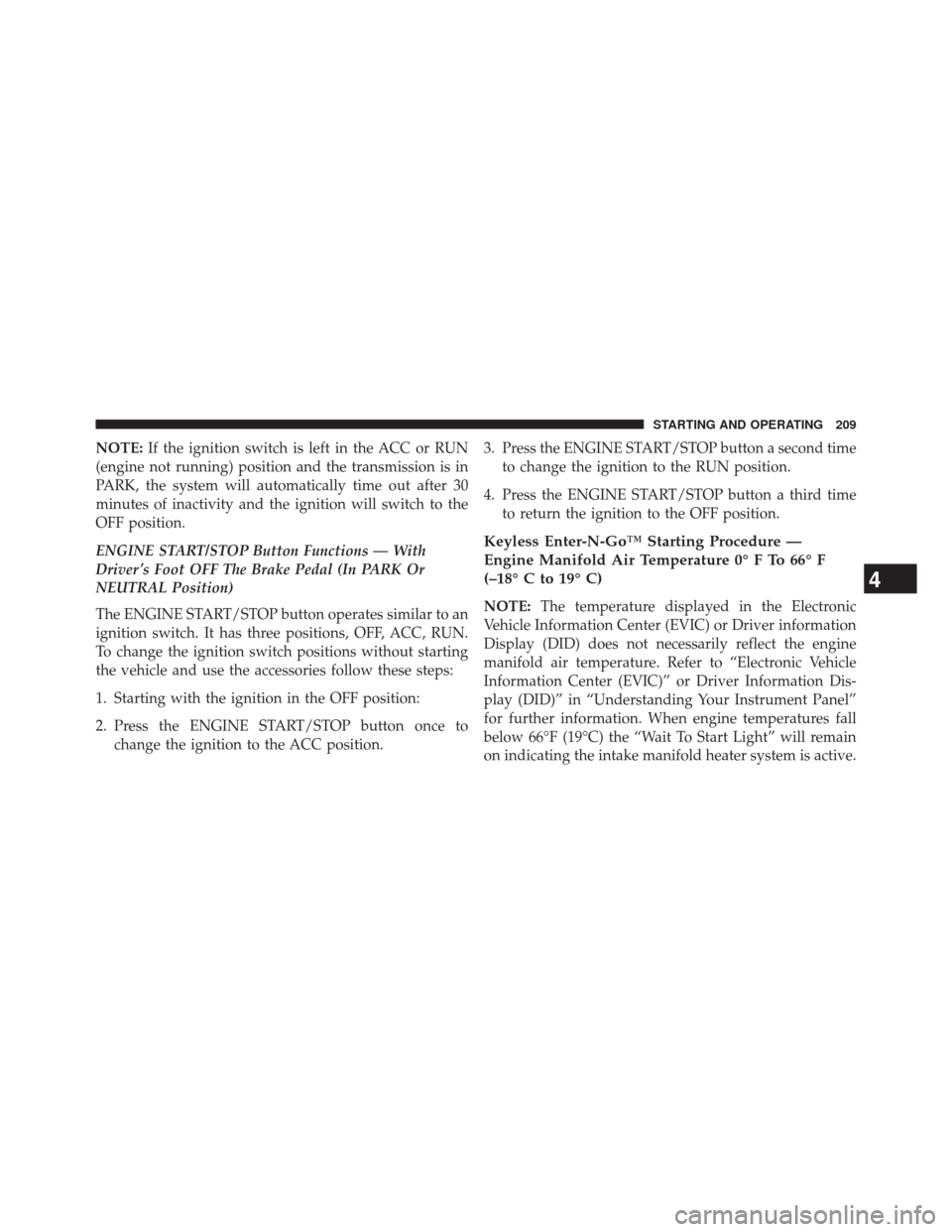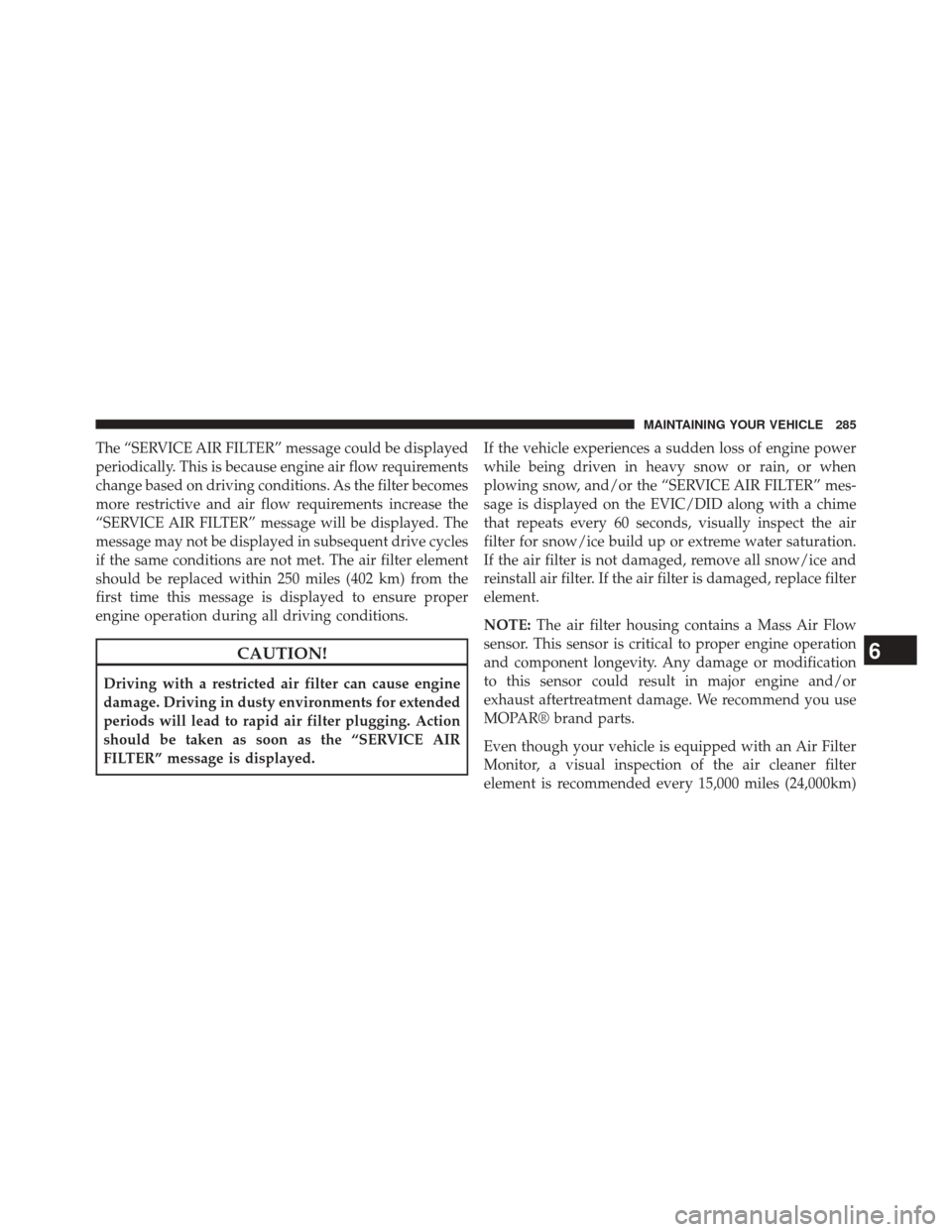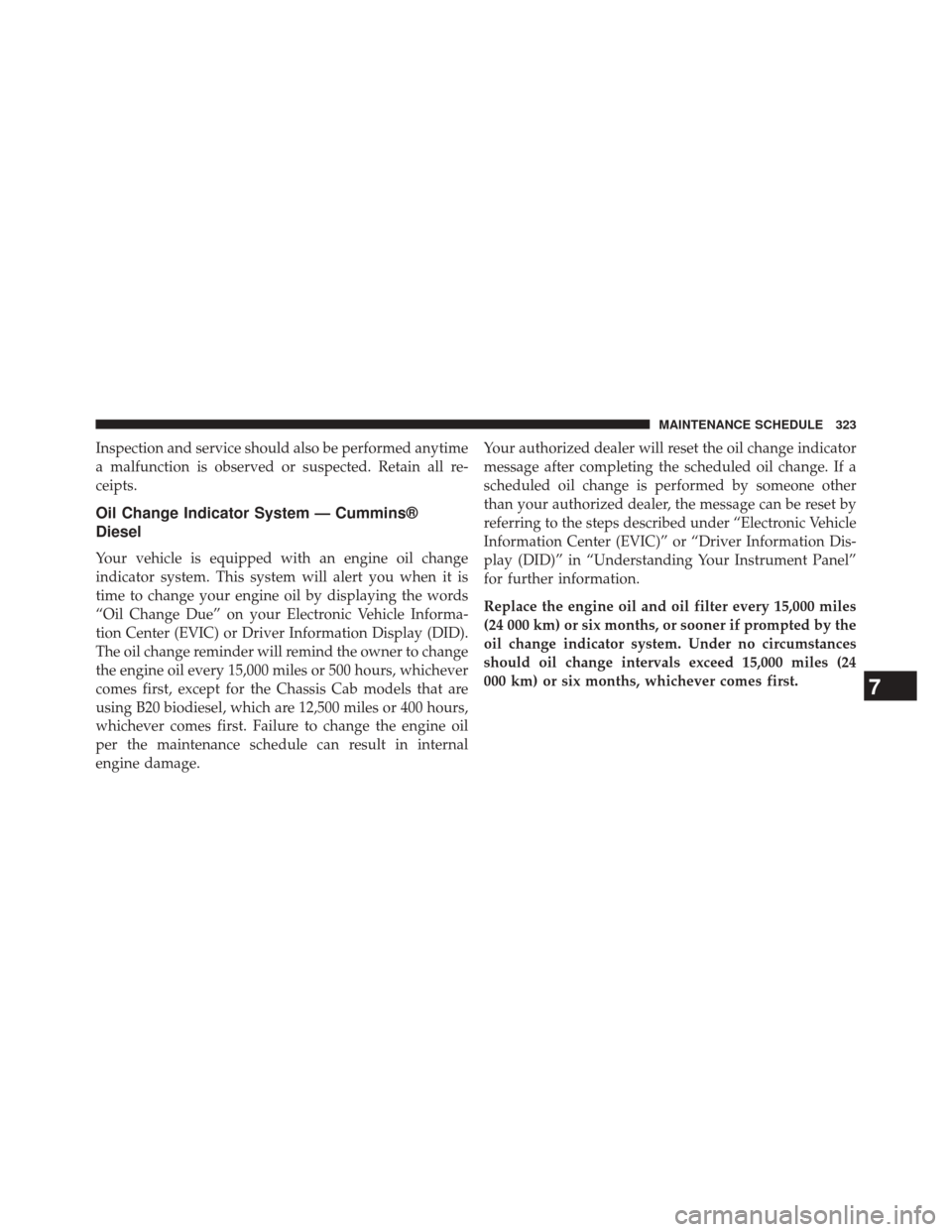Page 16 of 347
NOTE:Light duty operation such as light trailer towing
or no load operation will extend the time before the
engine is at full efficiency. Reduced fuel economy and
power may be seen at this time.
The engine oil installed in the engine at the factory is a
high-quality energy conserving type lubricant. Oil
changes should be consistent with anticipated climate
conditions under which vehicle operations will occur.
The recommended viscosity and quality grades are
shown under “Fluids, Lubricants and Genuine Parts”,
under “Maintaining Your Vehicle” in this manual. NON-
DETERGENT OR STRAIGHT MINERAL OILS MUST
NEVER BE USED.
14 THINGS TO KNOW BEFORE STARTING YOUR VEHICLE
Page 86 of 347

Do Not Operate The Engine With Failed Parts
All engine failures give some warning before the parts
fail. Be on the alert for changes in performance, sounds,
and visual evidence that the engine requires service.
Some important clues are:
•engine misfiring or vibrating severely
• sudden loss of power
• unusual engine noises
• fuel, oil or coolant leaks
• sudden change, outside the normal operating range, in
the engine operating temperature
• excessive smoke
• oil pressure drop
ENGINE BLOCK HEATER — IF EQUIPPED
The engine block heater warms engine coolant and
permits quicker starts in cold weather. Connect the heater
cord to a ground-fault interrupter protected 110–115 Volt
AC electrical outlet with a grounded, three-wire exten-
sion cord.
Its use is recommended for environments that routinely
fall below -10°F (-23°C). It should be used when the
vehicle has not been running for long periods of time and
should be plugged in two hours prior to start. Its use is
required for cold starts with temperatures under -20°F
(-28°C).
To ensure reliable starting at these temperatures, use of
an externally powered electric engine block heater (avail-
able from your authorized dealer) is recommended.
84 STARTING AND OPERATING
Page 130 of 347

MAINTENANCE SCHEDULE
Your vehicle is equipped with an automatic oil change
indicator system. The oil change indicator system will
remind you that it is time to take your vehicle in for
scheduled maintenance.
Based on engine operation conditions, the oil change
indicator message will illuminate. This means that ser-
vice is required for your vehicle. Operating conditions
such as frequent short-trips, trailer tow, extremely hot or
cold ambient temperatures will influence when the “Oil
Change Required” message is displayed. Severe Operat-
ing Conditions can cause the change oil message to
illuminate as early as 3,500 miles (5,600 km) since last
reset. Have your vehicle serviced as soon as possible,
within the next 500 miles (805 km).
Your authorized dealer will reset the oil change indicator
message after completing the scheduled oil change. If a
scheduled oil change is performed by someone otherthan your authorized dealer, the message can be reset by
referring to the steps described under “Electronic Vehicle
Information Center (EVIC)” or “Driver Information Dis-
play (DID)” in “Understanding Your Instrument Panel”
for further information.
NOTE:
Under no circumstances should oil change inter-
vals exceed 10,000 miles (16,000 km) or twelve months,
whichever comes first.
Once A Month Or Before A Long Trip:
• Check engine oil level
• Check windshield washer fluid level
• Check the tire inflation pressures and look for unusual
wear or damage
• Check the fluid levels of the coolant reservoir, brake
master cylinder and power steering, and fill as needed
• Check function of all interior and exterior lights
128 MAINTENANCE SCHEDULE
Page 132 of 347
Maintenance Chart — Diesel Fuel Up To B5 Biodiesel
Mileage or time passed (whichever comesfirst)
10,000
20,000
30,000
40,000
50,000
60,000
70,000
80,000
90,000
100,000
110,000
120,000
130,000
140,000
150,000
Or Years: 1 2 3 4 5 6 7 8 9 10 11 12 13 14 15
Or Kilometers:
16,000
32,000
48,000
64,000
80,000
96,000
112,000
128,000
144,000
160,000
176,000
192,000
208,000
224,000
240,000
Additional Inspections
Completely fill the Diesel Exhaust Fluid tank. X X X X X X X X X X X X X X X
Inspect the CV/Universal joints. XX X X X
Inspect front suspension, tie rod ends, and re-
place if necessary. XXX X X X X
Inspect the front and rear axle fluid. If gear oil
leakage is suspected, check the fluid level. If us-
ing your vehicle for police, taxi, fleet, off-road or
frequent trailer towing change the axle fluid. XXX X X X X
Inspect the brake linings, parking brake function. X X X X X X X
130 MAINTENANCE SCHEDULE
Page 134 of 347
Mileage or time passed (whichever comesfirst)
10,000
20,000
30,000
40,000
50,000
60,000
70,000
80,000
90,000
100,000
110,000
120,000
130,000
140,000
150,000
Or Years: 1 2 3 4 5 6 7 8 9 10 11 12 13 14 15
Or Kilometers:
16,000
32,000
48,000
64,000
80,000
96,000
112,000
128,000
144,000
160,000
176,000
192,000
208,000
224,000
240,000
Inspect the transfer case fluid, change for any of
the following: police, taxi, fleet, or frequent trailer
towing. XX
Change transfer case fluid. X
132 MAINTENANCE SCHEDULE
Page 211 of 347

NOTE:If the ignition switch is left in the ACC or RUN
(engine not running) position and the transmission is in
PARK, the system will automatically time out after 30
minutes of inactivity and the ignition will switch to the
OFF position.
ENGINE START/STOP Button Functions — With
Driver ’s Foot OFF The Brake Pedal (In PARK Or
NEUTRAL Position)
The ENGINE START/STOP button operates similar to an
ignition switch. It has three positions, OFF, ACC, RUN.
To change the ignition switch positions without starting
the vehicle and use the accessories follow these steps:
1. Starting with the ignition in the OFF position:
2. Press the ENGINE START/STOP button once to change the ignition to the ACC position. 3. Press the ENGINE START/STOP button a second time
to change the ignition to the RUN position.
4. Press the ENGINE START/STOP button a third time to return the ignition to the OFF position.
Keyless Enter-N-Go™ Starting Procedure —
Engine Manifold Air Temperature 0° F To 66° F
(–18° C to 19° C)
NOTE: The temperature displayed in the Electronic
Vehicle Information Center (EVIC) or Driver information
Display (DID) does not necessarily reflect the engine
manifold air temperature. Refer to “Electronic Vehicle
Information Center (EVIC)” or Driver Information Dis-
play (DID)” in “Understanding Your Instrument Panel”
for further information. When engine temperatures fall
below 66°F (19°C) the “Wait To Start Light” will remain
on indicating the intake manifold heater system is active.
4
STARTING AND OPERATING 209
Page 287 of 347

The “SERVICE AIR FILTER” message could be displayed
periodically. This is because engine air flow requirements
change based on driving conditions. As the filter becomes
more restrictive and air flow requirements increase the
“SERVICE AIR FILTER” message will be displayed. The
message may not be displayed in subsequent drive cycles
if the same conditions are not met. The air filter element
should be replaced within 250 miles (402 km) from the
first time this message is displayed to ensure proper
engine operation during all driving conditions.
CAUTION!
Driving with a restricted air filter can cause engine
damage. Driving in dusty environments for extended
periods will lead to rapid air filter plugging. Action
should be taken as soon as the “SERVICE AIR
FILTER” message is displayed.If the vehicle experiences a sudden loss of engine power
while being driven in heavy snow or rain, or when
plowing snow, and/or the “SERVICE AIR FILTER” mes-
sage is displayed on the EVIC/DID along with a chime
that repeats every 60 seconds, visually inspect the air
filter for snow/ice build up or extreme water saturation.
If the air filter is not damaged, remove all snow/ice and
reinstall air filter. If the air filter is damaged, replace filter
element.
NOTE:
The air filter housing contains a Mass Air Flow
sensor. This sensor is critical to proper engine operation
and component longevity. Any damage or modification
to this sensor could result in major engine and/or
exhaust aftertreatment damage. We recommend you use
MOPAR® brand parts.
Even though your vehicle is equipped with an Air Filter
Monitor, a visual inspection of the air cleaner filter
element is recommended every 15,000 miles (24,000km)
6
MAINTAINING YOUR VEHICLE 285
Page 325 of 347

Inspection and service should also be performed anytime
a malfunction is observed or suspected. Retain all re-
ceipts.
Oil Change Indicator System — Cummins®
Diesel
Your vehicle is equipped with an engine oil change
indicator system. This system will alert you when it is
time to change your engine oil by displaying the words
“Oil Change Due” on your Electronic Vehicle Informa-
tion Center (EVIC) or Driver Information Display (DID).
The oil change reminder will remind the owner to change
the engine oil every 15,000 miles or 500 hours, whichever
comes first, except for the Chassis Cab models that are
using B20 biodiesel, which are 12,500 miles or 400 hours,
whichever comes first. Failure to change the engine oil
per the maintenance schedule can result in internal
engine damage.Your authorized dealer will reset the oil change indicator
message after completing the scheduled oil change. If a
scheduled oil change is performed by someone other
than your authorized dealer, the message can be reset by
referring to the steps described under “Electronic Vehicle
Information Center (EVIC)” or “Driver Information Dis-
play (DID)” in “Understanding Your Instrument Panel”
for further information.
Replace the engine oil and oil filter every 15,000 miles
(24 000 km) or six months, or sooner if prompted by the
oil change indicator system. Under no circumstances
should oil change intervals exceed 15,000 miles (24
000 km) or six months, whichever comes first.
7
MAINTENANCE SCHEDULE 323